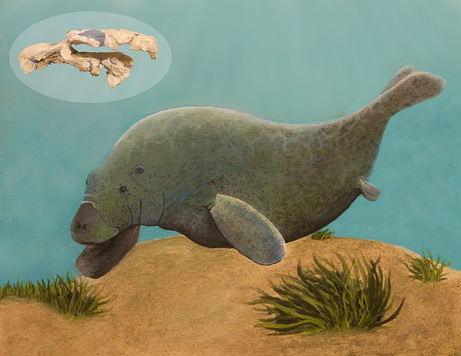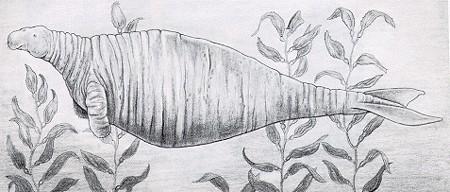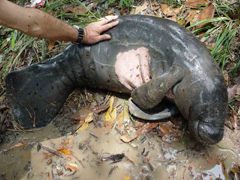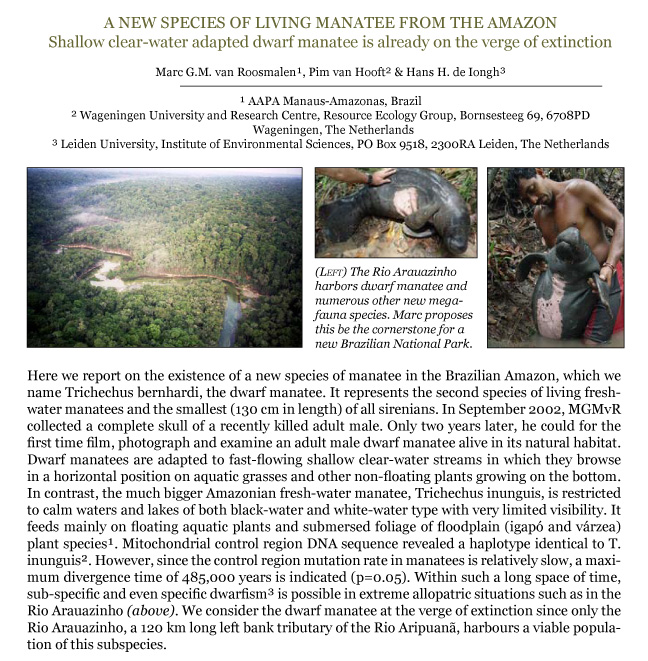New Pygmy Sea Cow Discovered
Posted by: Loren Coleman on December 29th, 2009

The announcement of an intriguing new species of Sirenia (i.e., manatees, dugongs, sea cows) was noted in the December 12, 2009, issue of the Journal of Vertebrate Paleontology. It is an extinct pygmy sea cow (Eotheroides lambondrano) ~ illustrated above with skull inset ~ from the island of Madagascar. It, thus, would have been a small relative of the Bering Sea’s Steller’s Sea Cow (Hydrodamalis gigas) ~ shown below.
Steller’s Sea Cow, of course, is also considered extinct, but still modern sightings are recorded for that species. Could the Madagascan pygmy sirenian explain reports of cryptids (e.g. merbeings) seen in recent times near Madagascar?

Rachel Kaufman of the National Geographic News summarized the new finding, which is given here, in part:
A new species of extinct pygmy sea cow is one of the first fossil mammal species found in Madagascar from the mysterious time period between 80 million years ago and 90,000 years ago, experts say.
…
Known from a roughly 40-million-year-old skull and a few ribs, the new species has been named Eotheroides lambondrano, after the Malagasy word for dugong, which translates to “water bushpig.” At about seven feet (two meters) long, the ancient pygmy sea cow was smaller than the modern dugong, which ranges from about 8 to 10 feet (2.4 to 3 meters) in length….E. lambondrano is also unique in that its closest relatives would have lived in what is now India and Egypt, according to the study—making its Madagascan location all the more special….”Madagascar already has a lot of strange beasts, and we now have a glimpse of this species from so far away.”

The discovery of a valid species of pygmy sea cow calls for a review of the latest on the Amazonian Dwarf Manatee debate. In regard to this alleged new species, Wikipedia has a good, new (December 23, 2009) overview of what has occurred since the announced “discovery” of this new species, written possibly by an unknown British or Canadian author (RN1970?), (given in plain text below to retain the italicized names, which are critical to the passage):
The Dwarf Manatee (Trichechus “pygmaeus”, or mistakenly Trichechus “bernhardi”) is a possible species of manatee that lives in the freshwater habitats of the Amazon, though restricted to one tributary of the Aripuanã River. According to Marc van Roosmalen, the scientist who proposes it as a new species, it lives in shallow, fast running water and feeds on different species of aquatic plants than the Amazonian Manatee, which prefers deeper slower moving waters and the plants found there. Based on its tiny range, it has been suggested that the Dwarf Manatee is critically endangered, but at present it is not recognized by the IUCN.
Dwarf Manatees are typically about 130 cm long, and weigh about 60 kg, making them the smallest extant sirenians. It is overall very dark, almost black, with a white patch on the abdomen. It has been suggested that it actually represents an immature Amazonian Manatee, but they are reported to differ in proportions and colour. They are, however, at least very closely related, as mtDNA has failed to reveal any difference between the two. Based on mutation rates in manatees – if the Dwarf Manatee is distinct – this suggests a divergence time of less than 485,000 years. Daryl Domning, a Smithsonian Institution research associate and the world’s foremost experts on manatee evolution, has stated that the DNA evidence actually proves that these merely are immature Amazonian Manatees.
Disregarding its questionable validity as a species, the proposed name “Trichechus pygmaeus” is problematic. A formal description using that name was submitted to Nature, but it was rejected and consequently the article has only been published online. This has resulted in the invalidation of the name following chapter 3, article 8 of the ICZN code. [End Wikipedia; see here for references.]

About Loren Coleman
Loren Coleman is one of the world’s leading cryptozoologists, some say “the” leading living cryptozoologist. Certainly, he is acknowledged as the current living American researcher and writer who has most popularized cryptozoology in the late 20th and early 21st centuries.
Starting his fieldwork and investigations in 1960, after traveling and trekking extensively in pursuit of cryptozoological mysteries, Coleman began writing to share his experiences in 1969. An honorary member of Ivan T. Sanderson’s Society for the Investigation of the Unexplained in the 1970s, Coleman has been bestowed with similar honorary memberships of the North Idaho College Cryptozoology Club in 1983, and in subsequent years, that of the British Columbia Scientific Cryptozoology Club, CryptoSafari International, and other international organizations. He was also a Life Member and Benefactor of the International Society of Cryptozoology (now-defunct).
Loren Coleman’s daily blog, as a member of the Cryptomundo Team, served as an ongoing avenue of communication for the ever-growing body of cryptozoo news from 2005 through 2013. He returned as an infrequent contributor beginning Halloween week of 2015.
Coleman is the founder in 2003, and current director of the International Cryptozoology Museum in Portland, Maine.










The illustration has an odd feature Loren
I have not read the article yet but did that drawing appear in the Journal of Vertebrate Paleontology?
Was the inset scull the only remains that lead to the reconstruction?
The illustrator has drawn a set of hind legs (though only one of the set showing).
I know Sirenia have vestigial hind limbs, but they are well hidden in the skeleton and do not erupt through
the outside of the body. Are they saying that the hind limbs were functional in Eotheroides lambondrano?
Interestingly Steller´s seacow was despite its enormous size not a true giant at all, but more some kind of dwarf among its kin. It evolved from the even larger and much more wide-spread species Hydrodamalis cuestae, and the smaller size was possibly a result of the small area where Hydrodamalis gigas lived as well as the geographical range in the north.